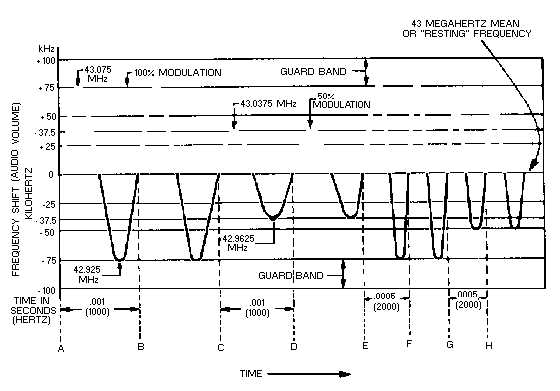2-12
Figure 2-8.—Frequency-modulating signal.
PERCENT OF MODULATION.—Before we explain 100-percent modulation in an fm system,
let's review the conditions for 100-percent modulation of an AM wave. Recall that 100-percent
modulation for AM exists when the amplitude of the modulation envelope varies between 0 volts and
twice its normal unmodulated value. At 100-percent modulation there is a power increase of 50 percent.
Because the modulating wave is not constant in voice signals, the degree of modulation constantly varies.
In this case the vacuum tubes in an AM system cannot be operated at maximum efficiency because of
varying power requirements.
In frequency modulation, 100-percent modulation has a meaning different from that of AM. The
modulating signal varies only the frequency of the carrier. Therefore, tubes do not have varying power
requirements and can be operated at maximum efficiency and the fm signal has a constant power output.
In fm a modulation of 100 percent simply means that the carrier is deviated in frequency by the full
permissible amount. For example, an 88.5-megahertz fm station operates at 100-percent modulation when
the modulating signal deviation frequency band is from 75 kilohertz above to 75 kilohertz below the
carrier (the maximum allowable limits). This maximum deviation frequency is set arbitrarily and will
vary according to the applications of a given fm transmitter. In the case given above, 50-percent
modulation would mean that the carrier was deviated 37.5 kilohertz above and below the resting
frequency (50 percent of the 150-kilohertz band divided by 2). Other assignments for fm service may
limit the allowable deviation to 50 kilohertz, or even 10 kilohertz. Since there is no fixed value for
comparison, the term "percent of modulation" has little meaning for fm. The term MODULATION
INDEX is more useful in fm modulation discussions. Modulation index is frequency deviation divided by
the frequency of the modulating signal.

